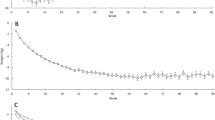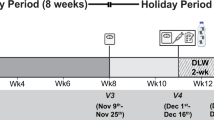Abstract
OBJECTIVE: The aim of the present study was to determine the impact of weight loss on appetite as measured by visual analog scale (VAS).
METHODS: Seventeen subjects (10 men and seven women) took part in a 15 week weight loss program which consisted of drug therapy (fenfluramine 60 mg/day) or placebo coupled to an energy restriction (−2930 kJ/day; phase 1) followed by an 18 week low-fat diet–exercise follow-up (phase 2). Subjects were given a standardized breakfast before and after phase 1 as well as after phase 2. Individuals were asked to fill out VAS before and at 0, 10, 20, 30, 40, 50 and 60 min after this test meal. Blood samples were drawn before the meal and at 0, 30 and 60 min postprandially and analyzed for glucose and insulin. Fasting plasma cortisol and leptin were also determined.
RESULTS: An increase in the fasting desire to eat, hunger and prospective food consumption (PFC) was observed after phase 1 and to an even greater extent after phase 2 in both men and women. In the fasting state, positive correlations were observed between changes in the desire to eat (r=0.76; P<0.05) as well as changes of PFC (r=0.82; P<0.05) and changes in cortisol at the end of phase 1 for women. In response to phase 1, statistically significant correlations were found between changes of hunger (r=0.64; P<0.05) and desire to eat (r=0.67; P<0.05) as measured by AUC in response to the meal and changes of fasting plasma cortisol in men. The most consistent predictor of changes of baseline desire to eat (r=0.68 P<0.05), fullness (r=−0.78, P<0.05) and PFC (r=0.91, P<0.01) during phase 2 was the change in fasting cortisol in men. Changes of fullness were also associated with changes of fasting leptin in men (r=0.68; P<0.05) during phase 2.
CONCLUSION: These results suggest that weight loss is accompanied by an increase of baseline appetite in both men and women and that the most consistent predictor of these changes in appetite seems to be changes in fasting plasma cortisol.
This is a preview of subscription content, access via your institution
Access options
Subscribe to this journal
Receive 12 print issues and online access
$259.00 per year
only $21.58 per issue
Buy this article
- Purchase on Springer Link
- Instant access to full article PDF
Prices may be subject to local taxes which are calculated during checkout


Similar content being viewed by others
References
Leaf A, Weber PC . A new era for science in nutrition Am J Clin Nutr 1987 45: 1048–1053.
Blundell J, Burley VJ, Cotton JR, Lawton CL . Dietary fat and control of energy intake: evaluating the effects of fat on meal size and postmeal satiety Am J Clin Nutr 1993 57: 772S–778S.
Lawton CL, Burley VJ, Wales JK, Blundell JE . Dietary fat and appetite control in obese subjects: weak effects on satiety Int J Obes Relat Metab Disord 1993 17: 409–416.
Aronne LJ, Mackintosh R, Rosenbaum M, Leibel RL, Hirsch J . Autonomic nervous system activity in weight gain and weight loss Am J Physiol 1995 269: R222–R225.
Considine RV, Shina MK, Heiman ML, Kriauciunas A, Stephens TW, Nyce MR, Ohanessian JP, Marco CC, McKee LJ, Bauer TL, Caro JF . Serum immunoreactive-leptin concentrations in normal-weight and obese subjects N Engl J Med 1996 334: 292–295.
Goldstein DJ . Beneficial health effects of modest weight loss Int J Obes Relat Metab Disord 1992 16: 397–415.
Bray GA . Food intake, sympathetic activity, and adrenal steroids Brain Res Bull 1993 32: 537–541.
Halaas JL, Gajiwala KS, Maffei M, Cohen SL, Chait BT, Rabinowitz D, Lallone RL, Burley SK, Friedman JM . Weight-reducing effects of the plasma protein encoded by the obese gene Science 1995 269: 543–546.
Schwartz MS, Figlewicz DP, Baskin DG, Woods SC, Porte D . Insulin in the brain: a hormonal regulator of energy balance Endocrinol Rev 1992 13: 387–414.
Schwartz MW, Sipols AJ, Marks JL, Sanacora G, White JD, Scheurink A, Kahn SE, Baskin DG, Woods SC, Figlewicz DP, Porte D . Inhibition of hypothalamic neuropeptide Y gene expression by insulin Endocrinology 1992 130: 3608–3616.
Wing RR, Klein R, Moss SE . Weight gain associated with improved glycemic control in population-based sample of subjects with type I diabetes Diabetes Care 1990 13: 1106–1109.
Campfield LA, Smith FJ . Functional coupling between transient declines in blood glucose and feeding behavior: temporal relationships Brain Res Bull 1986 17: 427–433.
Campfield LA, Smith FJ . Transient declines in blood glucose signal meal initiation Int J Obes 1990 14: 15–31.
Weinsier RL, Neslon KM, Hensrud DD, Darnell BE, Hunter GR, Schutz Y . Metabolic predictors of obesity J Clin Invest 1995 95: 980–985.
Heini AF, Kirk KA, Lara-Castro C, Weinsier RL . Relationship between hunger-satiety feelings and various metabolic parameters in women with obesity during controlled weight loss Obes Res 1998 6: 225–230.
Heini AF, Lara-Castro C, Kirk KA, Considine RV, Caro JF, Weinsier RL . Association of leptin and hunger-satiety ratings in obese women Int J Obes Relat Metab Disord 1998 22: 1084–1087.
Raynaud E, Brun JF, Perez-Martin A, Sagnes C, Boularan AM, Fedou C, Mercier J . Serum leptin is associated with the perception of palatability during a standardized high-carbohydrate breakfast test Clin Sci (Colch) 1999 96: 343–348.
Keim NL, Stern JS, Havel PJ . Relation between circulating leptin concentrations and appetite during a prolonged, moderate energy deficit in women Am J Clin Nutr 1998 68: 794–801.
Doucet E, Imbeault P, Almeras N, Tremblay A . Physical activity and low-fat diet: is it enough to maintain weight stability in the reduced-obese individual following weight loss by drug therapy and energy restriction? Obes Res 1999 7: 323–333.
Khan MA, Herzog CA, St Peter JV, Hartley GG, Madlon-Kay R, Dick CD, Asinger RW, Vessey JT . The prevalence of cardiac valvular insufficiency assessed by transthoracic echocardiography in obese patients treated with appetite-suppressantdrugs N Engl J Med 1998 339: 713–718.
Weissman NJ, Tighe JFJ, Gottdiener JS, Gwynne JT . An assessment of heart-valve abnormalities in obese patients taking dexfenfluramine, sustained-release dexfenfluramine, or placebo. Sustained-release dexfenfluramine study group. N Engl J Med 1998 339: 725–732.
Prud'homme D, Langlais M, Samson MP, Gallagher P, Turcotte J, Tremblay A, Després J-P . Lack of major cardiac valvular abnormalities in asymptomathic obese men and women following a 3-month fenfluramine or dexfenfluramine treatment Int J Obes Relat Metab Disord 1999 23: S175.
Hill AJ, Blundell JE . The effects of a high-protein or high-carbohydrate meal on subjective motivation to eat and food preferences Nutr Behav 1986 3: 133–144.
Arvaniti K, Richard D, Tremblay A . Reproducibility of energy and macronutrient intake and related substrate oxidation rates in a buffet-type meal Br J Nutr (in press).
Richterich R, Dauwwalder H . Zur bestimmung der plasmaglukose-konzentration mit der hexokinase-glucose-6-phosphat-deshydrogenase-methode Schweiz Med Wochenschr 1971 101: 615–618.
Desbuquois B, Aurbach GD . Use of polyethylene glycol to separate free and antibody-bound peptide hormones in radioimmunoassays J Clin Endocrinol Metab 1971 37: 732–738.
Couillard C, Mauriege P, Prud'homme D, Nadeau A, Tremblay A, Bouchard C, Despres JP . Plasma leptin concentrations: gender differences and associations with metabolic risk factors for cardiovascular disease Diabetologia 1997 40: 1178–1184.
Pasman WJ, Saris WH, Westerterp-Plantenga MS . Predictors of weight maintenance Obes Res 1999 7: 43–50.
Imbeault P, Saint-Pierre S, Almeras N, Tremblay A . Acute effects of exercise on energy intake and feeding behaviour. Br J Nutr 1997 77: 511–521.
Kissileff HR, Pi-Sunyer FX, Segal K, Meltzer S, Foelsch PA . Acute effects of exercise on food intake in obese and nonobese women Am J Clin Nutr 1990 52: 240–245.
Zhang Y, Proenca R, Maffei M, Barone M, Leopold L, Friedman JM . Positional cloning of the mouse obese gene and its human homologue Nature 1994 372: 425–432.
Karhunen L, Haffner S, Lappalainen R, Turpeinen A, Miettinen H, Uusitupa M . Serum leptin and short-term regulation of eating in obese women Clin Sci 1997 92: 573–578.
Scholz GH, Englaro P, Thiele I, Scholz M, Klusmann T, Kellner K, Rascher W, Blum WF . Dissociation of serum leptin concentration and body fat content during long term dietary intervention in obese individuals Horm Metab Res 1996 28: 718–723.
Arvaniti K, Deshaies Y, Richard D . Effect of leptin on energy balance does not require the presence of intact adrenals Am J Physiol 1998 275: R105–111.
Dagnault A, Deshais Y, Richard D . Effects of the 5-hydroxytryptamine agonist D, L-fenfluramine on energy balance in rats: influence of gender Int J Obes Relat Metab Disord 1993 17: 367–373.
Burlet C . Stress and feeding behavior Ann Endocrinol 1988 49: 141–145.
Timofeeva E, Richard D . Functional activation of CRH neurons and expression of the genes encoding CRH and its receptors in food-deprived lean ( Fa/?) and obese (fa/fa) Zucker rats Neuroendocrinology 1997 66: 327–340.
Acknowledgements
This research was supported by grants from Servier Canada and FCAR Québec.
Author information
Authors and Affiliations
Corresponding author
Appendix A
Appendix A

Rights and permissions
About this article
Cite this article
Doucet, E., Imbeault, P., St-Pierre, S. et al. Appetite after weight loss by energy restriction and a low-fat diet–exercise follow-up. Int J Obes 24, 906–914 (2000). https://doi.org/10.1038/sj.ijo.0801251
Received:
Revised:
Accepted:
Published:
Issue Date:
DOI: https://doi.org/10.1038/sj.ijo.0801251
Keywords
This article is cited by
-
Identification of adipose tissue transcriptomic memory of anorexia nervosa
Molecular Medicine (2023)
-
Adipocytes control food intake and weight regain via Vacuolar-type H+ ATPase
Nature Communications (2022)
-
The anti-obesity effect of mulberry leaf (Mori Folium) extracts was increased by bioconversion with Pectinex
Scientific Reports (2022)
-
The Impact of Restrictive and Non-restrictive Dietary Weight Loss Interventions on Neurobehavioral Factors Related to Body Weight Control: the Gaps and Challenges
Current Obesity Reports (2021)
-
Association of Exercise with Control of Eating and Energy Intake
Current Addiction Reports (2019)



